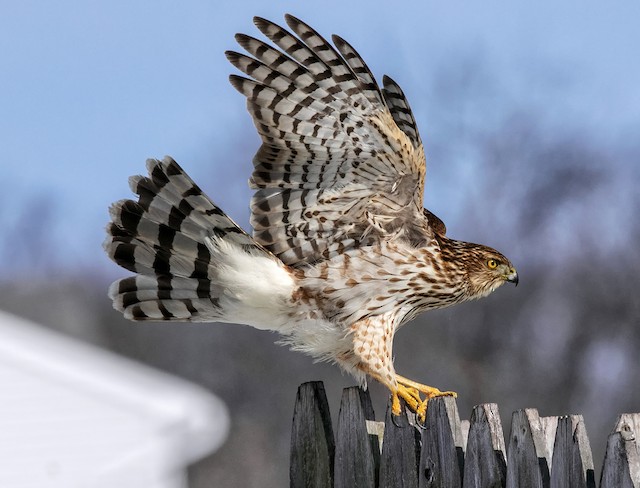Birds of prey and other predators
Is there any real danger?

Occasionally spring, in early April, a hawk seems to have taken up residence in our neighbourhood. The first time we saw it, the hawk was perched on the peak of the roof and setting up quite a racket. Not knowing what it was, we were unsure whether there might be any reason for concern with our Havanese playing in the backyard. A call to a local wildlife store identified our visitor as a Cooper's hawk; also known as a Chicken Hawk as they were once believed to prey on farmers chickens.
Cooper's hawks, like other birds of prey, have keen vision and strong talons. They like to perch in high places or hide under cover in watchful surveillance, swoop down in surprise attacks and snatch their prey. They may also scout around in high flight or adopt short swift pursuits in low flight. A Copper's hawk's diet consists mainly of small and medium birds, and also includes rodents and small mammals such as moles, mice, squirrels and less frequently, an occasional rabbit or hare. As natural habitats are destroyed, hawks, like other wildlife, are becoming accustomed to the presence of humans and are adapting to living in urban centers where food sources may be temptingly more easily obtainable than in their ordinary habitats. Wildlife observations indicate that dogs are rarely in danger from hawks however a hungry hawk or one with young to feed might occasionally try and catch things outside the weight/size range of its normal prey. This does not happen with regularity and is the rare exception rather than the rule.
Havanese are very quick and agile little dogs, they run and dart about, changing directions on a dime with play habits that may mimic escaping prey. Just how tempting is that to a hawk? A full grown adult Havanese is likely quite safe from a small/medium bird of prey like the Cooper's hawk that is about the size of a large crow. Young Havanese puppies however, the size/weight of a large squirrel or a young rabbit could potentially be at risk. Common sense and vigilance will help keep your little ones safe if there are any such predators in your neighbourhood.
Havanese owners in rural locations may possibly encounter larger hawks, owls and eagles which may pose more significant risks. While one might not be able to fly away with a Havanese, even a ground attack or a failed attempt has the potential to result in serious injuries. Occasionally, but thankfully very rarely, the media reports an attack on a family cat or small dog. Such incidents are quite unusual and definitely not the norm and usually attributed to larger birds of prey. In rural areas, Havanese owners also need to keep watch for four-legged predators such as coyotes and bobcats.
If you have any predators in your area, it a wise precaution to know what they are, areas they may frequent, and their dietary habits and to know if there are any potential risks to you Havanese puppies or adults. The knowledge may keep your precious pets safe.